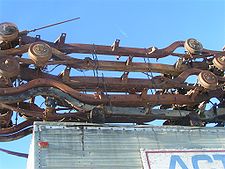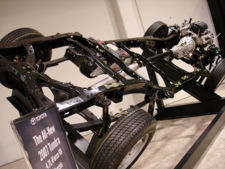
Body-on-frame
Encyclopedia


Automobile
An automobile, autocar, motor car or car is a wheeled motor vehicle used for transporting passengers, which also carries its own engine or motor...
construction method. Mounting a separate body
Coachwork
Coachwork is the body of a horse-drawn coach or carriage, a motor vehicle , a railroad car or railway carriage. Usually reserved for bodies built on a separate chassis, rather than being of unitary or monocoque construction...
to a rigid frame that supports the drivetrain
Powertrain
In a motor vehicle, the term powertrain or powerplant refers to the group of components that generate power and deliver it to the road surface, water, or air. This includes the engine, transmission, drive shafts, differentials, and the final drive...
was the original method of building automobiles, and its use continues to this day. The original frames were made of wood (commonly ash
Ash tree
Fraxinus is a genus flowering plants in the olive and lilac family, Oleaceae. It contains 45-65 species of usually medium to large trees, mostly deciduous though a few subtropical species are evergreen. The tree's common English name, ash, goes back to the Old English æsc, while the generic name...
), but steel ladder frames became common in the 1930s. It is technically not comparable to newer monocoque designs, almost no modern vehicle uses it (other than trucks).
In the USA the frequent changes in automobile design made it necessary to use a ladder frame rather than monocoque
Monocoque
Monocoque is a construction technique that supports structural load by using an object's external skin, as opposed to using an internal frame or truss that is then covered with a non-load-bearing skin or coachwork...
to make it possible to change the design without having to change the chassis
Chassis
A chassis consists of an internal framework that supports a man-made object. It is analogous to an animal's skeleton. An example of a chassis is the underpart of a motor vehicle, consisting of the frame with the wheels and machinery.- Vehicles :In the case of vehicles, the term chassis means the...
, allowing frequent changes and improvements to the car's bodywork and interior (where they were most noticeable to customers) while leaving the chassis and driveline unchanged, and thus keeping cost down and design time short. It was also easy to use the same chassis and driveline for several very different cars. Especially in the days before computer-aided design
Computer-aided design
Computer-aided design , also known as computer-aided design and drafting , is the use of computer technology for the process of design and design-documentation. Computer Aided Drafting describes the process of drafting with a computer...
, this was a big advantage.
Most small passenger vehicles switched to monocoque
Monocoque
Monocoque is a construction technique that supports structural load by using an object's external skin, as opposed to using an internal frame or truss that is then covered with a non-load-bearing skin or coachwork...
construction in the 1960s, but the trend had started in the 1930s with cars like the Opel Olympia
Opel Olympia
The Opel Olympia is a small family car produced by the German automaker Opel from 1935 to 1940, from 1947 to 1953 and again from 1967 to 1970.The 1935 Olympia was Germany's first mass-produced car with an all-steel unitized body . This revolutionary technology reduced the weight of the car by 180...
, and Citroen Traction Avant
Citroën Traction Avant
The Citroën Traction Avant is an automobile which was produced by the French manufacturer Citroën from 1934 to 1957. About 760,000 units were produced.-Impact on the world:...
leaving just truck
Truck
A truck or lorry is a motor vehicle designed to transport cargo. Trucks vary greatly in size, power, and configuration, with the smallest being mechanically similar to an automobile...
s, some bus manufacturers
Bus manufacturing
Bus manufacturing is a specific sector of the automotive industry, which carries out the manufacturing of buses and coaches.-History:Bus manufacturing had its earliest origins in carriage building. Other bus manufacturers had their origins in truck manufacturing...
and large cars using conventional frames
Frame (vehicle)
A frame is the main structure of the chassis of a motor vehicle. All other components fasten to it; a term for this is design is body-on-frame construction.In 1920, every motor vehicle other than a few cars based on motorcycles had a frame...
. The switch continued for several decades - even small SUVs typically use this construction method today. Body-on-frame remains the preferred construction method for heavy-duty commercial vehicles, especially those intended to carry or pull heavy loads, such as trucks. The Ford Crown Victoria, which was discontinued in 2011 was the last passenger car to be built in this manner.
A halfway house to full monocoque construction was the 'semi-monocoque' used by the Volkswagen Beetle
Volkswagen Beetle
The Volkswagen Type 1, widely known as the Volkswagen Beetle or Volkswagen Bug, is an economy car produced by the German auto maker Volkswagen from 1938 until 2003...
and Citroen 2CV
Citroën 2CV
The Citroën 2CV |tax horsepower]]”) was an economy car produced by the French automaker Citroën between 1948 and 1990. It was technologically advanced and innovative, but with uncompromisingly utilitarian unconventional looks, and deceptively simple Bauhaus inspired bodywork, that belied the sheer...
. These used a lightweight separate chassis made from pressed sheet steel panels forming a 'platform chassis', to give the benefits of a traditional chassis, but with lower weight and greater stiffness. Both of these chassis were used for several different models. Volkswagen made use of the bodyshell for structural strength as well as the chassis - hence 'semi-monocoque'.
The Lincoln Town Car
Lincoln Town Car
The Lincoln Town Car is a full-size luxury sedan that was sold by the upscale Lincoln division of Ford Motor Company; it was produced from 1981 to the 2011 model years...
dominates the American limousine market because it is the last American luxury car made with body-on-frame, and therefore easily lengthened for livery work.
Advantages
- Easier to design, build and modify (less of an issue now that Computer-Assisted Design (CAD) is commonplace, but still an advantage for coach-built vehicles).
- Quieter, because the stresses do not pass into the body, which is isolated from the frame with rubber pads around the attachment bolts. Less significant lately, but earlier bodies would squeak and rattle, ever more as they rusted, lubricants drained, and fasteners loosened. Isolated bodies had a lesser degree of these modes of aging.
- Easier to repair after accidents. Grand-AmGrand American Road Racing AssociationGRAND-AM Road Racing or GRAND-AM is an auto racing sanctioning body that was established in 1999 to organize road racing competitions in North America...
allows tubular spaceframe cars to replace their monocoque counterparts, as the cars can easily be repaired with new clips. - Could allow a manufacturer to easily sub-contract portions of work, e.g. as when AustinAustin Motor CompanyThe Austin Motor Company was a British manufacturer of automobiles. The company was founded in 1905 and merged in 1952 into the British Motor Corporation Ltd. The marque Austin was used until 1987...
subcontracted the aluminum body work of the Austin A40 SportsAustin A40 SportsSee Austin A40 for other A40 models.The Austin A40 Sports debuted at the 1949 London Motor Show as a four-passenger, aluminium-bodied convertible version of the Austin A40 — carrying an Austin of England nameplate, bearing the marque's Flying A hood ornament, and designed and manufactured in...
to Jensen MotorsJensen MotorsJensen Motors Ltd was a British manufacturer of sports cars and commercial vehicles, based in the Lyng – West Bromwich...
.

Disadvantages
- Heavier than unibody - lower performance and/or higher fuel consumption.
- Far less resistant to torsional flexing (flexing of the whole car in corners) - compromising handling and road grip.
- No crumple zoneCrumple zoneThe crumple zone is a structural feature mainly of automobiles. Crumple zones have also been incorporated into railcars in recent years.They are designed to absorb the energy from the impact during an accident by controlled deformation. This energy is much higher than is commonly recognized...
- higher rate of death and serious injury. Some cars have adopted a "front clip" and "rear clip" format similar to what is used in NASCAR race cars where the car is split into three sections, and the clips absorb the impact, allowing the "clip" to be replaced when repairing the car. - Structurally poor utilization of material.
See also
- Frame (vehicle)Frame (vehicle)A frame is the main structure of the chassis of a motor vehicle. All other components fasten to it; a term for this is design is body-on-frame construction.In 1920, every motor vehicle other than a few cars based on motorcycles had a frame...
- Body Frame Integral
- CoachworkCoachworkCoachwork is the body of a horse-drawn coach or carriage, a motor vehicle , a railroad car or railway carriage. Usually reserved for bodies built on a separate chassis, rather than being of unitary or monocoque construction...
- Monocoque
- Spaceframe
- SubframeSubframeA subframe is a structural component of a vehicle, such as an automobile or an aircraft, that uses a discrete, separate structure within a larger body-on-frame or unit body to carry certain components, such as the engine, drivetrain, or suspension. The subframe is bolted and/or welded to the vehicle...
- SuperleggeraSuperleggeraSuperleggera is an automobile chassis construction technology developed by Felice Bianchi Anderloni of Italian coachbuilder Carrozzeria Touring. The company was located just north of Milan, near Alfa Romeo, Italian Citroen, and the former Isotta-Fraschini plant...
- ChassisChassisA chassis consists of an internal framework that supports a man-made object. It is analogous to an animal's skeleton. An example of a chassis is the underpart of a motor vehicle, consisting of the frame with the wheels and machinery.- Vehicles :In the case of vehicles, the term chassis means the...
- Backbone chassisBackbone chassisBackbone tube chassis is a type of an automobile construction chassis that is similar to the body-on-frame design. Instead of a two-dimensional ladder type structure, it consists of a strong tubular backbone that connects the front and rear suspension attachment areas...

